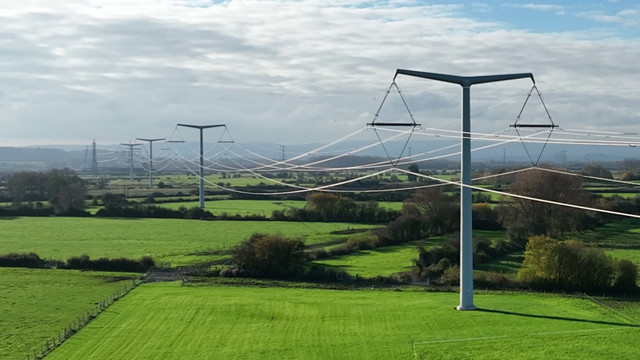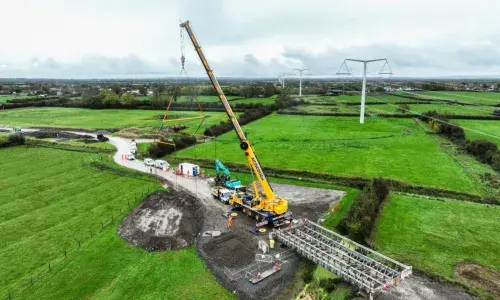
It is T-Time! All T-pylons now erected on the Hinkley Connection Project
T-pylon with diamond insulators
116 T-structures complete and 232 diamond 'earrings' now in situ.
As the 232nd diamond-shaped insulator was lifted into place by crane onto a T-pylon between Yatton and Kenn in North Somerset on 11 July, National Grid and principal contractor, Balfour Beatty celebrated the completion of all 116 T-pylon structures that are being built as part of the Hinkley Connection Project.
Representing a world first for pylon design, the first T-pylon to be built was constructed in September 2021 near East Huntspill.
T-pylons are quicker to erect than traditional lattice pylons and 47 more T-pylons were completed, including installation of the conductors by the end of 2022.
36 new T-pylons between Woolavington and Loxton were energised in early 2023, meaning high voltage energy is now running along the new T-pylons, cables under the Mendip Hills Area of Outstanding Natural Beauty and the newly built substation at Sandford.
At the same time work began to build the 68 T-pylons running north of Sandford substation to Portbury. With the hanging of 232nd diamond insulator which will hold the high voltage conductors, those 68 T-pylon structures are now complete.
All the T-pylons will be energised by the end of 2024. Before then, conductors will be hung from the T-pylons and the last of 249 traditional lattice pylons and 67km of overhead wires will be removed from the landscape to make way for the new electricity connection.
Roxane Fisher-Redel, Senior Project Manager for National Grid on the Hinkley Connection Project said: “National Grid’s T-pylons are the first new design for overhead electricity lines in over a century and will play a central role in connecting low carbon energy to millions of people when Hinkley Point C begins generation.
“Erecting all the 116 T-pylon structures is a huge milestone and now we look ahead to 2025 and full completion of this project which will play such a key role in transmitting cleaner, homegrown, energy around the UK – enough to power 6 million homes and businesses.”
The T-pylons were designed the reduce the visual impact of the 57-kilometre connection route on the landscape as a direct response to community feedback.
At 35m high, they are a third shorter than National Grid's traditional lattice transmission pylons and take up far less room on the land.
Watch related video


